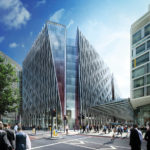The Latin word for solstice translates as the sun stopping or standing still. So, as we enjoy the longest day of the year, with the sun standing still above us for 17 hours, we can look ahead to the days shortening, without having to consider the difficulties that used to accompany the shortened daylight hours before the widespread introduction of street lighting.
Since the Victorians street lighting has become an ever-present fixture as part of our city streets and has given space to a much safer and active city after sunset. Now in 2023, well-designed street lighting often goes unnoticed. Our subconscious clarity of visibility, feelings of increased safety and the assurance lighting can provide is often taken for granted.
Street lighting is an essential element of good public realm. Well-lit streets activate spaces for all users, all year round.
An often-overlooked challenge for new commercial and residential developments is ensuring their new public spaces connect well to the neighbouring street lighting. An overly-lit street lighting route can change a softly-lit public realm from welcoming to unnerving. Conversely a low level of street lighting can contrast with a public realm space making it feel a clinical and hard space. Greenery and wildlife in public spaces can suffer greatly where overly bright street lighting disrupts the space and the connection to other green spaces. Ensuring street lighting is well designed and meets – or exceeds – is a key element to activating public realm spaces.
Unlike the sun on this summer solstice day, the conversations around street lighting don’t stand still, with many interesting developments on the horizon.
Safer walking routes home – spaces for everyone
Well-lit spaces provide the feeling of reassurance and safety. A spread of light uniformly across the public realm removes dimly lit spaces that can create uncertainty for someone walking home. The tragic murder of Sarah Everard in London has re-ignited discussions around safer streets, particularly for women in cities. One idea to surface is well-lit routes being introduced to navigation apps such as Google Maps and Citymapper. This would direct people away from dimly-lit areas, such as parks, and quiet, poorly-lit routes and instead via well-lit streets.
Questions arise on monitoring and maintenance for local highway authorities and the data sharing with app providers. There are mutually beneficial elements to this app feature, to both the provider and local authorities. For example, a regularly-updated night-time street view on Google Maps could include a lighting assessment that local authorities use as a monitoring and maintenance tool. The clear benefits for app users and the appetite app providers have for standing out above others could see this feature introduced in the near future.
Too bright
Over recent years street lighting has experienced an LED revolution where the long-used sodium lanterns have been replaced with LED luminaires. These LED luminaires are not only more energy efficient but can also spread light to suit particular street layouts, offer brighter lighting in different light colours, and use local light sensors to turn on and off. A current challenge for public spaces following the upgrade to more powerful LED luminaires is over lighting public . We might assume that the brighter the space, the better. But in fact, over lit spaces can be uncomfortable to the human eye which needs time to adapt to transitions in lighting. The LED revolution is a great improvement for street lighting but requires pushing further to enable better, more holistic designs.
There is currently little consideration of surrounding lighting from private areas when developing a street lighting design. In city centres the ambient light from private shops, advertisements and architectural lighting can contribute significantly to how well a space is lit. Incorporating the private light contribution to the public space, into the design process, would provide a more holistic design. Although this has challenges regarding assessing the private lighting and its control and monitoring, this is something that other areas of highways and public realm design already achieves (for example drainage design ensuring private surface water runoff is dealt with correctly).
Re-wilding cities
London is now considered a Nation Park City, so wildlife habitat within the city should be considered further within street lighting design. Well-lit space is a key component to designing spaces that encourage wildlife to take up our streets for homes. In recent decades cities were designed for cars to navigate and the idea of cities for pedestrians and cyclists would have felt a strange phenomenon. Today that seems a distant and strange time. I hope that in the decades to come city designers reflect on our time in a similar way with cities designed for people and also wildlife.
Energy bills
Producing holistic street lighting designs that do not overly light spaces but use less light, and therefore energy, also provides benefit to local authorities’ energy budgets. It’s important to note that this does not mean making the city darker to achieve cost savings – but instead stripping away unnecessary lighting and lighting the right places in the right way. The average local authority spends around a third of its energy costs on street lighting. During this time of high energy bills and cost of living crisis, reducing these bills with better designed streets, is a simple win for the lighting providers and users.
As we strive to provide more holistic well-designed spaces, I believe we will discover how much more our well-lit streets can offer to making our city the best place to be.



